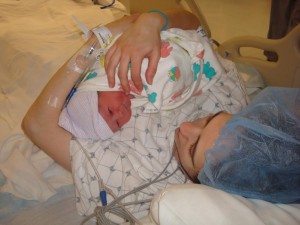Editor’s note: April is Cesarean Awareness Month, an observance of the International Cesarean Awareness Network designed to reduce unnecessary cesareans, advocate for VBAC (vaginal birth after cesarean) and help women heal from the sometimes-difficult emotions surrounding a cesarean birth. While Attachment Parenting International (API) promotes childbirth options with the least interventions, we also recognize that there are certain situations that necessitate interventions. What is most important is that parents research all of their options to be able to make an informed decision:
 Sometimes, moms who know during pregnancy that they want to practice Attachment Parenting worry that it will be more difficult or impossible after a cesarean birth. But as with any birth experience, the first few days or weeks don’t define your relationship with your child. Attachment is an ongoing process.
Sometimes, moms who know during pregnancy that they want to practice Attachment Parenting worry that it will be more difficult or impossible after a cesarean birth. But as with any birth experience, the first few days or weeks don’t define your relationship with your child. Attachment is an ongoing process.
Practicing Attachment Parenting after a cesarean may be a slightly different experience than after a vaginal delivery, but it is still absolutely possible.
From my personal experience, I have learned the following 5 lessons of Attachment Parenting following a cesarean birth:
- Breastfeeding — It’s a myth that you can’t breastfeed after a cesarean or that it’s always harder for the baby to start breastfeeding. My 2 cesarean babies were champion nursers in the recovery room. But, in some cases, it may take a little more time to get started. Sometimes it takes more time for the milk to come in, and it may be more difficult to find a comfortable nursing position. The football hold is one of the best positions for a mom who has just had a cesarean, as it keeps the pressure away from the incision area. In any situation, a challenging start to nursing doesn’t mean that one can’t successfully breastfeed long-term, and with help and support, most moms certainly can breastfeed after a cesarean.
- Babywearing — In the first few weeks after a cesarean, babywearing is difficult, if not impossible, because many carriers will put too much pressure on the mom’s abdomen. Even having the baby positioned higher up on mom’s body for too long can lead to some internal discomfort later in the day. So, it may be best to wait on babywearing, but that doesn’t mean that it can’t happen at all! Missing out on wearing my son soon after birth didn’t affect our future babywearing, which we did comfortably until he started crawling and no longer wanted to be contained. In fact, I wore him so frequently over those months that it was difficult for me emotionally to realize that this chapter of our relationship was ending.
- Cosleeping — It was also possible for us to cosleep after the cesarean. It was actually easier that way than having my son in a crib, because it wasn’t possible for me to bend down and lift him out. The only concern was to be sure that the baby’s feet weren’t going to kick or bump the incision area.
- Preparing for a family-centered cesarean — In some situations, moms know in advance that they’re having a cesarean. In this case, moms can try to make it a more positive experience by looking into a family-centered, or gentle, cesarean. This looks different for every family, but it may include having the cesarean performed slowly with the baby walked out gently, having one arm unrestrained in order to hold the baby as early as possible, playing music in the operating room, having the screen lowered at the time of delivery, and breastfeeding in the operating or recovery room. When I learned that my third baby was breech and that I’d be having a repeat cesarean instead of the VBAC I desired, I created a gentle cesarean birth plan, which helped me take control of my birth experience.
- Negative birth experience — In some cases, a cesarean is not what a mom wants. She may be unhappy with the way events progressed during her labor or with interventions she didn’t want. She may feel that she didn’t have enough control over her body. Women are sometimes even told that they shouldn’t care that the birth didn’t go as planned, because all that really matters is that the baby is healthy. It is important to acknowledge that negative feelings about any birth experience can sometimes make it more difficult for a new mom to bond with her baby, and what a new mom in this situation often needs is support. Support comes in many forms. It may be from friends and family, from your local API leader and API Support Group, from a postpartum doula or a medical professional. But even moms who are unhappy with their births or suffer from postpartum depression after the birth can successfully bond and parent in an attached, connected way throughout the child’s life.
Additional API Resources on Gentle Cesarean Births
API’s First Principle of Parenting: Prepare for Pregnancy, Birth and Parenting
Personal stories on APtly Said, API’s blog:
— “A special door“
— “I took back control of my cesarean”
Professional insight on The Attached Family, API’s online magazine:
